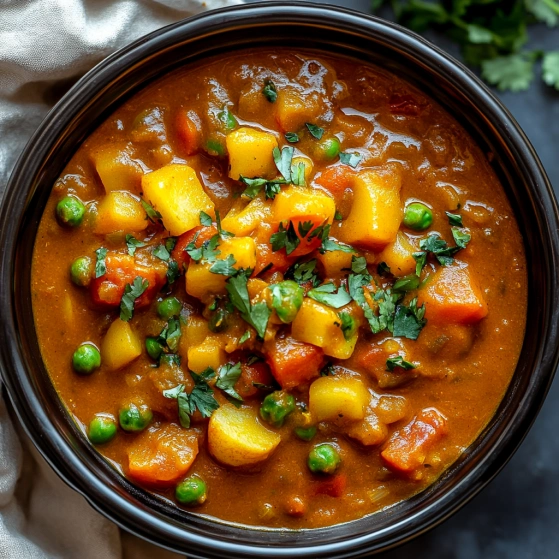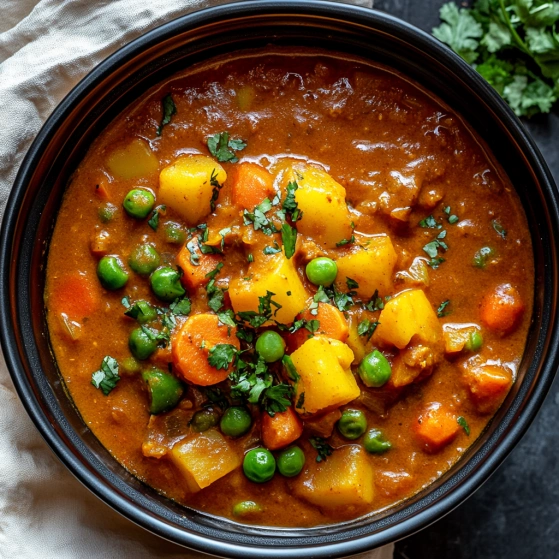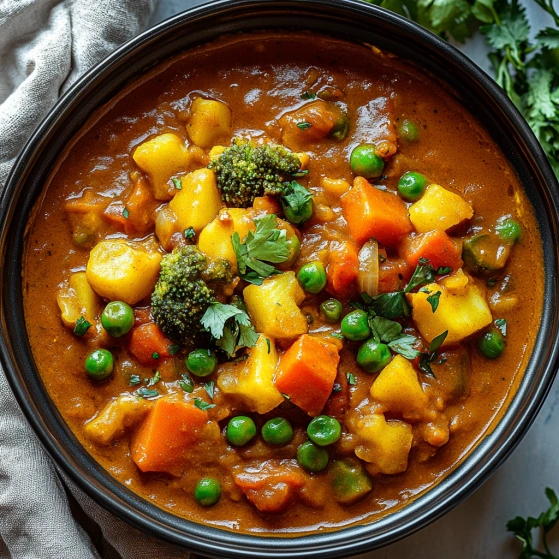 Pin it
Pin it
Vegetable curry is a vibrant one-pot meal that combines aromatic spices with tender vegetables and creamy coconut milk. This slow cooker version eliminates the need to stand over a hot stove, allowing the flavors to meld beautifully as they simmer together. The result is a richly flavored, comforting dish that works perfectly as a weeknight dinner or weekend meal prep option.
I made this curry last weekend when I had friends coming over but needed to run errands all afternoon. When we returned to the house, everyone immediately commented on the incredible aroma. The curry had developed such depth of flavor that my friend Sarah asked for the recipe before even tasting it!
Ingredients
- Coconut milk: Provides the creamy, rich base for the curry. Look for full-fat versions for the best texture and flavor.
- Diced tomatoes: Adds acidity to balance the richness of the coconut milk. The undrained juices help create the perfect sauce consistency.
- Mixed vegetables: I recommend carrots for sweetness, bell peppers for color, and peas added near the end for brightness. Choose vegetables with similar cooking times or cut slower-cooking ones smaller.
- Onion: Forms the aromatic foundation of the curry. Yellow or red onions work equally well.
- Garlic: Provides essential flavor depth. Fresh cloves yield the best result, but pre-minced works in a pinch.
- Curry powder: The heart of this dish. If possible, choose a recently purchased curry powder as the spices lose potency over time.
- Cumin: Adds earthy warmth that complements the curry powder beautifully.
- Salt and pepper: Essential for bringing all the flavors together.
- Fresh cilantro: Provides a bright, fresh counterpoint to the rich curry. If you're in the cilantro-tastes-like-soap camp, substitute fresh basil or flat-leaf parsley.
- Rice or naan: Essential for soaking up the delicious sauce. Basmati rice or homemade naan are my top recommendations.
Step-by-Step Cooking Instructions
- Step 1:
- Prepare the vegetables. Start by washing all vegetables thoroughly. Dice the onion into small, uniform pieces about 1/4 inch in size so they'll melt into the sauce. Mince the garlic cloves finely or use a garlic press. Cut carrots into coins or half-moons about 1/4 inch thick. Dice bell peppers into 1/2-inch squares. If using fresh peas, shell them; if frozen, keep them aside to add later. Having all vegetables prepped before starting makes assembly much easier.
- Step 2:
- Combine ingredients in slow cooker. Open your coconut milk and stir well before adding to the slow cooker, as it often separates in the can. Pour in the entire can of diced tomatoes with their juice. Add all your prepared vegetables except frozen peas (if using). Sprinkle the curry powder, cumin, a teaspoon of salt, and 1/2 teaspoon of black pepper over everything. The spices should be distributed evenly throughout the mixture.
- Step 3:
- Mix thoroughly. Using a large wooden spoon, stir all ingredients until fully combined. Make sure to scrape the bottom and sides of the slow cooker to incorporate any spices that might stick there. The mixture should have a consistent appearance with the spices evenly distributed throughout the sauce.
- Step 4:
- Set cooking time. Cover the slow cooker with its lid, ensuring it's properly sealed. Set to cook on low for 6-7 hours if you want the flavors to develop slowly and vegetables to maintain some texture. Choose high for 3-4 hours if you're shorter on time. Avoid lifting the lid during cooking as this releases heat and extends cooking time.
- Step 5:
- Final adjustments and serving. In the last 30 minutes of cooking, add frozen peas if using them, and taste to adjust seasonings. You may need more salt depending on your vegetables and preferences. Once done, the sauce should be slightly thickened and vegetables tender but not mushy. Serve in deep bowls over rice or with warm naan bread on the side. Generously sprinkle with freshly chopped cilantro just before serving.
 Pin it
Pin it
My mother-in-law was initially skeptical about vegetable curry, having grown up on meat-centered meals. After trying this recipe during a weekend visit, she was genuinely surprised by how satisfying and flavorful it was without any meat. Now she makes it regularly and has started experimenting with different vegetables and spice levels.
Make It Your Own
This vegetable curry recipe serves as a wonderful foundation that you can easily adapt to your preferences or what's available in your pantry. Sweet potatoes add wonderful texture and natural sweetness, while cauliflower absorbs the curry flavors beautifully. For a protein boost, consider adding a can of drained chickpeas during the last hour of cooking. Don't be afraid to adjust the spice level - start with the recommended amount of curry powder, then increase it gradually in future batches if you prefer more heat. Remember that slow cooking tends to mellow spices, so what might seem strong when first added will balance nicely by serving time.
Troubleshooting Common Issues
The texture of your vegetable curry can vary depending on several factors that are easy to adjust. If your curry turns out too watery, remove the lid for the last 30 minutes of cooking to allow some liquid to evaporate. Conversely, if it's too thick, add a splash of vegetable broth or water to reach your desired consistency. Sometimes vegetables release different amounts of liquid based on their freshness or type. If you notice your curry isn't as flavorful as you'd like, try adding a teaspoon of garam masala during the last 15 minutes of cooking - this spice blend adds tremendous depth without requiring additional cooking time to integrate.
 Pin it
Pin it
Serving Suggestions
While rice and naan are traditional accompaniments to curry, there are numerous ways to serve this versatile dish. For a lower-carb option, cauliflower rice makes an excellent base that complements the curry flavors without competing with them. When hosting dinner parties, I love to create a curry bar with various toppings like toasted cashews, raisins, mango chutney, and yogurt so guests can customize their bowls. Leftover curry also transforms wonderfully into new meals - try using it as a filling for savory crepes, stirring it into beaten eggs for a flavorful scramble, or even using it as an unexpected baked potato topping. The complex flavors actually improve after a day in the refrigerator, making this an ideal make-ahead dish.
Frequently Asked Questions
- → Can I use any vegetables for this dish?
Yes! Feel free to use your favorite vegetables like zucchini, potatoes, or broccoli in addition to or instead of the listed ones.
- → Can I make this on the stovetop instead of a slow cooker?
Absolutely! Sauté the onions and garlic first, then add the remaining ingredients and simmer the curry on low until the vegetables are tender.
- → Can I make it spicier?
Yes, you can add a pinch of chili powder, cayenne pepper, or fresh chopped chili to increase the heat level.
- → How do I store leftovers?
Store leftovers in an airtight container in the refrigerator for up to 3-4 days. Reheat gently on the stovetop or in the microwave.
- → Is this dish vegan and gluten-free?
Yes, this curry is naturally vegan and gluten-free as long as you ensure your ingredients, like curry powder, contain no gluten.
